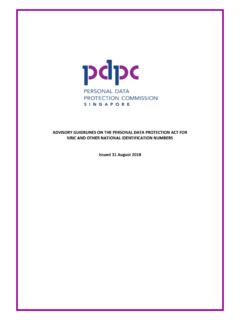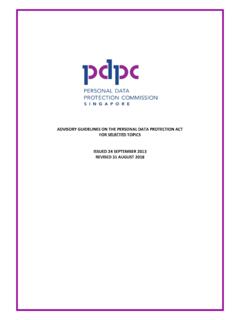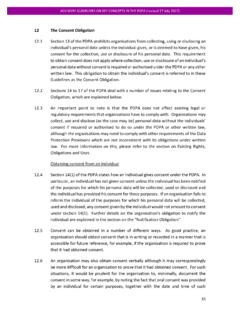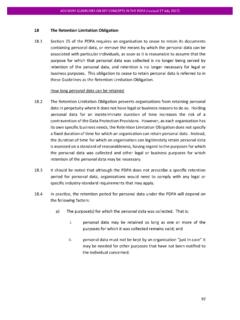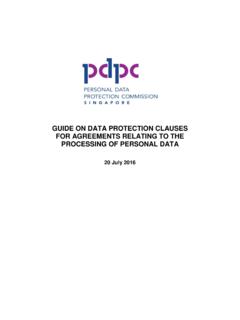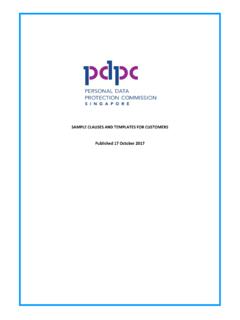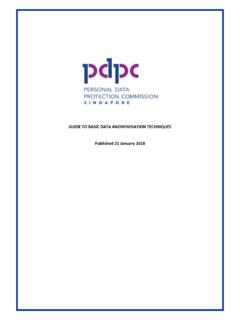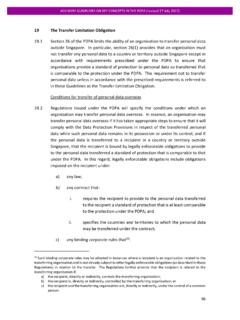Transcription of MODEL ARTIFICIAL INTELLIGENCE GOVERNANCE …
1 MODEL ARTIFICIAL INTELLIGENCE GOVERNANCE FRAMEWORK 1 ARTIFICIAL INTELLIGENCEGOVERNANCE FRAMEWORKMODELSECOND EDITIONSUMMARY OF UPDATES .. 4 FOREWORD .. 71. PREAMBLE .. 92. INTRODUCTION .. 12 Objectives .. 13 Guiding Principles for the MODEL Framework .. 15 Assumptions .. 17 Definitions .. 183. MODEL AI GOVERNANCE FRAMEWORK .. 19 Internal GOVERNANCE Structures and Measures .. 21 Determining the Level of Human Involvement in AI-augmented Decision-making .. 28 Operations Management .. 35 Stakeholder Interaction and Communication .. 53 ANNEX A For Reference: A Compilation of Existing AI ethical Principles .. 64 ANNEX BAlgorithm Audits .. 67 ACKNOWLEDGEMENTS .. 68 TABLE OF CONTENTS4 EDITIONDATE RELEASEDSUMMARYFIRST23 January 2019 Released the MODEL AI GOVERNANCE Framework (First Edition) at the 2019 World Economic Forum Annual Meeting in Davos, January 2020 Released the MODEL AI GOVERNANCE Framework (Second Edition) at the 2020 World Economic Forum Annual Meeting in Davos, key changes include: Addition of industry examples in each section to illustrate how organisations have implemented AI GOVERNANCE practices in that section; Updating the titles of two sections to accurately reflect their content: Determining AI Decision-Making MODEL to Determining the level of human involvement in AI-augmented decision-making ; Customer Relationship Management to Stakeholder interaction and communication.
2 Section-specific changes include the following:Determining the level of human involvement in AI-augmented decision-making Clarified the human-over-the-loop approach by explaining the human s supervisory role in AI-augmented decision-making. Clarified that organisations can consider other factors such as the nature and reversibility of harm and operational feasibility in determining the level of human involvement in an organisation s decision-making process involving UPDATESMODEL ARTIFICIAL INTELLIGENCE GOVERNANCE FRAMEWORK 5 EDITIONDATERELEASEDSUMMARYSECOND21 January 2020 Operations management Provided guidance to organisations to adopt a risk-based approach when implementing measures by: Identifying features or functionalities with the greatest impact on stakeholders; Considering which measure would be most effective in building trust with stakeholders.
3 Provided guidance on the necessity and relevance of the various measures: Clarified that datasets used for building AI models may include both personal and non-personal data; Included new measures such as robustness, reproducibility and auditability and provided examples of helpful practices for these interaction and communication Highlighted the importance of communication with various internal and external stakeholders. Highlighted the need to consider the purpose and context when interacting with the various stakeholders. Provided suggestions on the level of information to be provided when interacting with various stakeholders. Annex A For reference: a compilation of existing AI ethical principles (Annex A) Clarified that the list of AI ethical principles provided is a compilation of existing AI principles that is for reference only.
4 Not all listed principles are addressed in the MODEL AI GOVERNANCE Framework. Organisations could consider incorporating other principles in Annex A into their own corporate principles. 6 EDITIONDATERELEASEDSUMMARYSECOND21 January 2020 Annex B Algorithm Audits Clarified that an algorithm audit is to be conducted only if it is necessary to discover the actual operations of algorithms comprised in models, and only at the request of a regulator (as part of a forensic investigation). Annex C Use Case Annex C has been removed. Instead, a separate Compendium of Use Cases has been published ( ).In 2019, the world saw significant advances in the sophistication and pervasive use of ARTIFICIAL INTELLIGENCE ( AI ). For instance, we witnessed the emergence of next-generation AI-powered natural text generators like GPT-2, which can generate passages that are difficult to distinguish from human writing.
5 We also saw the development of Dactyl, a robotic hand, which uses reinforcement learning to grasp and manipulate common household objects with human-like dexterity. These examples attest to the speed of AI s advancement and how itwill become ubiquitous in our daily discourse on AI ethics and GOVERNANCE has also moved forward. Over the last two years, governments and international organisations have begun issuing principles, frameworks and recommendations on AI ethics and GOVERNANCE . In January 2019, Singapore launched our MODEL AI GOVERNANCE Framework ( MODEL Framework ) at the World Economic Forum in Davos. The MODEL Framework s unique contribution to the global discourse on AI ethics lies in translating ethical principles into practical recommendations that organisations could readily adopt to deploy AI responsibly.
6 We are heartened by the diversity of organisations that have adopted the practices outlined in the MODEL Framework, which underscores its ease-of-use and is proud to launch the second edition of the MODEL Framework. This edition incorporates the experiences of organisations that have adopted AI, and feedback from our participation in leading international platforms, such as the European Commission s High-Level Expert Group and the OECD Expert Group on AI. Such input has enabled us to provide clearer and effective guidance for organisations to implement AI ARTIFICIAL INTELLIGENCE GOVERNANCE FRAMEWORK 78 Singapore s Info-communications Media Development Authority ( IMDA ) and Personal Data Protection Commission ( PDPC ) have also partnered the World Economic Forum Centre for the Fourth Industrial Revolution to develop an Implementation and Self-Assessment Guide for Organisations ( ISAGO ).
7 The ISAGO complements the MODEL Framework by allowing organisations to assess the alignment of their AI GOVERNANCE practices with the MODEL Framework, while providing useful industry examples and practices. We are also publishing a Compendium of Use Cases, which features real-world examples of how organisations have implemented or aligned their AI GOVERNANCE practices with the MODEL Framework. Together, these initiatives enable any organisation to establish and refine its AI GOVERNANCE practices in concrete and practical initiatives play a critical role in Singapore s National AI Strategy. They epitomise our plans to develop a human-centric approach towards AI GOVERNANCE that builds and sustains public trust. They also reflect our emphasis on co-creating an AI ecosystem in a collaborative and inclusive manner.
8 The MODEL Framework and ISAGO will pave the way for future developments, such as the training of professionals on ethical AI deployment, and laying the groundwork for Singapore, and the world, to better address AI s impact on steps we take today will leave an indelible imprint on our collective future. The MODEL Framework has been recognised as a firm foundation for the responsible use of AI and its future evolution. We will build on this momentum to advance a human-centric approach to AI one that facilitates innovation and safeguards public trust to ensure AI s positive impact on the world for generations to IswaranMinister for Communications and InformationSingaporeJanuary 2020 MODEL ARTIFICIAL INTELLIGENCE GOVERNANCE FRAMEWORK 91. PREAMBLEMODEL ARTIFICIAL INTELLIGENCE GOVERNANCE FRAMEWORK The MODEL Framework focuses primarily on four broad areas: internal GOVERNANCE structures and measures, human involvement in AI-augmented decision-making, operations management and stakeholder interaction and communication.
9 While the MODEL Framework is certainly not limited in ambition, it is ultimately limited by form, purpose and practical considerations of scope. With that in mind, several caveats bear mentioning. The MODEL Framework is a. Algorithm-agnostic It does not focus on specific AI or data analytics methodology. It applies to the design, application and use of AI in Technology-agnostic It does not focus on specific systems, software or technology, and will apply regardless of development language and data storage Sector-agnostic It serves as a baseline set of considerations and measures for organisations operating in any sector to adopt. Specific sectors or organisations may choose to include additional considerations and measures or adapt this baseline set to meet their needs. The PDPC encourages and will collaborate with public agencies adapting the MODEL Framework for their Scale- and Business- MODEL -agnostic It does not focus on organisations of a particular scale or size.
10 It can also be used by organisations engaging in business-to-business or business-to-consumer activities and operations, or in any other business ARTIFICIAL INTELLIGENCE GOVERNANCE FRAMEWORK It is recognised that there are a number of issues that are closely interrelated to the ethical use and deployment of AI. This MODEL Framework does not focus on these specific issues, which are often sufficient in scope to warrant separate study and treatment. Examples of these issues include:a. Articulating a new set of ethical principles for AI. There are already a number of attempts globally in establishing a universal set of principles. While a consistent core set of ethical principles is emerging, there is also a penumbra of variation across cultures, jurisdictions and industry sectors. The MODEL Framework uses existing and common AI ethical principles (a compilation of which is set out in Annex A) and converts them into implementable Providing MODEL frameworks and addressing issues around data sharing, whether between the public and private sectors or between organisations or within consortia.
